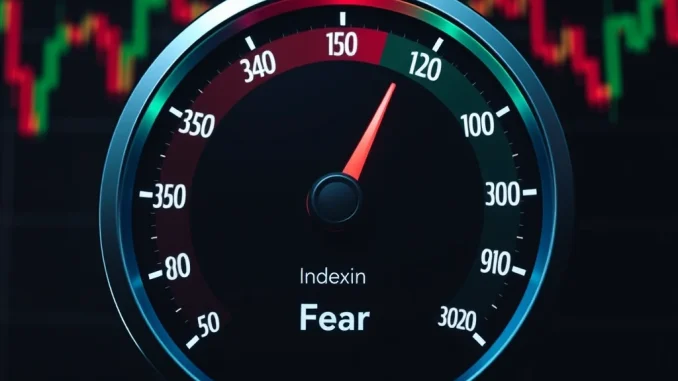
Navigating the volatile world of cryptocurrency can feel like riding a rollercoaster. One moment you’re soaring with optimism, the next you’re plummeting into a pit of despair. To help decipher these market emotions, the Crypto Fear & Greed Index emerges as a crucial tool. Let’s dive into the latest readings and understand what they signal for the crypto landscape.
Crypto Fear and Greed Index: A Glimmer of Hope or Continued Caution?
As of April 17th, the Crypto Fear & Greed Index, a widely followed metric by crypto enthusiasts, registered a value of 30. This figure, provided by Alternative.me, marks a marginal increase of one point from the previous day. While any upward movement might be perceived as positive, it’s crucial to note that the index remains firmly entrenched within the “Fear” zone. This indicates that despite a slight improvement in market sentiment, a prevailing sense of caution, or even anxiety, continues to dominate the cryptocurrency market.
| Index Value | Sentiment Zone |
|---|---|
| 0-24 | Extreme Fear |
| 25-49 | Fear |
| 50-74 | Greed |
| 75-100 | Extreme Greed |
Understanding the Fear & Greed Index Zones
Decoding the Crypto Fear & Greed Index: What Factors Drive Market Sentiment?
So, what exactly fuels this fear and greed index? It’s not just a random number plucked from thin air. Alternative.me meticulously compiles this index by analyzing a diverse set of factors, providing a holistic view of market emotions. Let’s break down the six key components that contribute to the final score:
- Volatility (25%): Market volatility is a significant fear indicator. High volatility often triggers uncertainty and anxiety among investors. The index measures the current volatility and compares it with the 30-day and 90-day averages to gauge the level of fear driven by price swings.
- Market Momentum/Volume (25%): This factor examines market momentum and trading volume in relation to recent averages. Strong buying momentum and high volume can suggest growing greed, while weak momentum and low volume might indicate fear or disinterest.
- Social Media (15%): Social media sentiment plays an increasingly vital role in shaping market perceptions. The index analyzes social media platforms to gauge the overall buzz and sentiment surrounding cryptocurrencies. A surge in positive social media discussions can point towards growing greed, while negative sentiment can amplify fear.
- Surveys (15%): While currently paused, traditional surveys used to directly measure investor sentiment. These surveys gauged the emotions and expectations of crypto traders and investors, contributing to the overall index score. When active, they provided direct insights into market sentiment.
- Bitcoin Dominance (10%): Bitcoin dominance, the ratio of Bitcoin’s market capitalization to the total cryptocurrency market cap, offers clues about market sentiment. Increased Bitcoin dominance can sometimes indicate a ‘flight to safety’ during fearful times, as investors flock to the perceived stability of Bitcoin. Conversely, decreasing dominance might suggest a higher risk appetite and greed as investors explore altcoins.
- Google Trends (10%): Google Trends data for Bitcoin-related search queries provides insights into general public interest and curiosity. A spike in searches like “Bitcoin price manipulation” or “Bitcoin crash” can signal increased fear, while searches for “buy Bitcoin” might indicate growing greed.
Why Does the ‘Fear’ Zone Persist Despite a Slight Uptick in the Bitcoin Fear Index?
Even with a one-point rise, the Bitcoin fear index remains in the “Fear” zone. This raises the question: why? Several factors could contribute to this persistent fear, even with a minor improvement:
- Broader Economic Uncertainty: Global economic conditions, including inflation concerns, interest rate hikes, and geopolitical tensions, can cast a shadow over the crypto market. These macro factors can override minor improvements in crypto-specific sentiment.
- Recent Market Corrections: The crypto market has experienced significant corrections recently. The memory of these downturns can linger in investor psychology, maintaining a cautious or fearful outlook even during periods of slight recovery.
- Regulatory Scrutiny: Ongoing regulatory discussions and actions around the world continue to inject uncertainty into the crypto space. Concerns about potential stricter regulations can dampen enthusiasm and contribute to a fearful market sentiment.
- Lagging Indicators: It’s possible that some of the factors influencing the crypto sentiment are lagging indicators. For example, social media sentiment or Google Trends might take time to fully reflect a shift in market mood. A one-day increase in the index might be too short to signal a definitive trend reversal.
Actionable Insights: Leveraging the Crypto Fear & Greed Index for Smarter Decisions
The Crypto Fear & Greed Index isn’t just an interesting number to observe; it’s a valuable tool for making more informed crypto investment decisions. Here’s how you can use it to your advantage:
- Contrarian Investing: Many seasoned investors use the Fear & Greed Index as a contrarian indicator. Extreme fear (index near 0) might be seen as a buying opportunity, suggesting that assets are undervalued due to panic selling. Conversely, extreme greed (index near 100) could signal an overheated market and a potential time to take profits or reduce exposure.
- Sentiment Confirmation: Use the index to confirm your own market analysis. If your research suggests a potential market downturn, and the index is also trending towards “Fear,” it can reinforce your assessment and strengthen your conviction to act accordingly.
- Risk Management: The index can help you gauge the overall risk level in the market. Higher fear levels might indicate increased volatility and potential for further downside, prompting you to adjust your portfolio risk accordingly. Lower fear (or increasing greed) might suggest a more stable or bullish environment.
- Long-Term Perspective: Avoid making impulsive short-term decisions solely based on daily fluctuations of the index. Focus on the broader trend over weeks and months. The index is most effective when used in conjunction with other fundamental and technical analysis tools, especially for long-term investment strategies.
Conclusion: Navigating Crypto’s Emotional Waters with the Fear & Greed Index
The Crypto Fear & Greed Index, while showing a marginal increase to 30, serves as a crucial reminder that market sentiment remains cautious. Understanding the factors that drive this index – from volatility and market momentum to social media and Bitcoin dominance – empowers you to interpret market emotions more effectively. By incorporating this index into your analysis, you can move beyond emotional reactions and make more strategic, data-driven decisions in the dynamic world of cryptocurrency. Keep an eye on this valuable indicator, but remember to always conduct thorough research and consider your own risk tolerance when navigating the exciting, yet sometimes fearful, crypto landscape.



